Havana Relic: From School to Ruins
By Yusimi Rodriguez, Photos: Irina Echarry
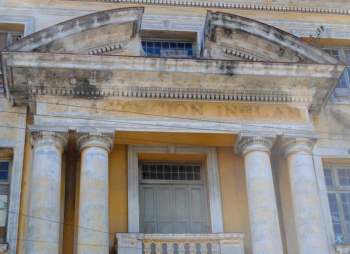 HAVANA TIMES, March 6 — I discovered this building in 2010. I was walking down Carmen Street on the way to a friend’s house and curiosity stopped me. Of course I wanted to know the previous use of this enormous building, now half destroyed and that looked completely abandoned.
HAVANA TIMES, March 6 — I discovered this building in 2010. I was walking down Carmen Street on the way to a friend’s house and curiosity stopped me. Of course I wanted to know the previous use of this enormous building, now half destroyed and that looked completely abandoned.
But that notion became irrelevant as soon as I saw a woman emerging from the structure. I walked over to her to confirm what to me was incredible. “Yes,” she responded to my question, and with the upmost naturalness. “In total, eleven families live here in this building, including two people who’ve been here for more than thirty-five years,” she explained.
Unable to get it out of my mind, I’ve returned here almost one year later to find out more about the building and its residents. When was it built? What was its original purpose? How did it end up in this condition? And why do these people live here?
Another resident from neighborhood satisfied part of my curiosity saying: “I studied here. First it was a religious school, later an elementary school. And now…ruins.”
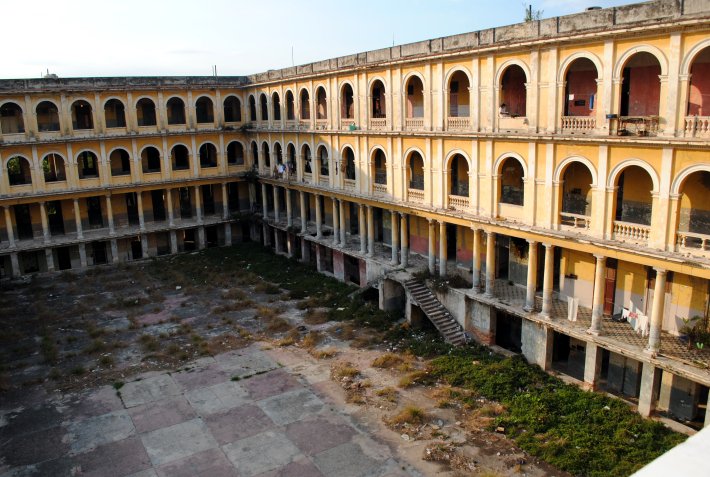 Some very old people who live in front told me that the building was donated to a religious institution by the Inclan family back in the 1920s so that it would serve as a school for poor children.
Some very old people who live in front told me that the building was donated to a religious institution by the Inclan family back in the 1920s so that it would serve as a school for poor children.
Gladys is a teacher who retired after working for 33 years in that field and who has been a resident of the building for more than thirty-five years. She told me: “This was a school of nuns and priests. This was where they lived and taught. After the revolution, the government intervened and it became the Center for Female Continuing Education; young women from different provinces studied here…”
“Then they turned it into another center and it became a boarding school for elementary school children; the kids lived here full time. But later it became a semi-boarding school; the children came in the morning and left in the afternoon.
“The school didn’t receive the maintenance it needed for a long time. From the time I began working here it didn’t receive any maintenance, and about twenty or twenty-five years ago they closed it for repairs. But the repairs they made were only to the façade – a lot of paint, some windows, just touch ups…
“After the five years, it was necessary to close the school again because the work they did was shoddy, plus there was no one there to oversee or control the quality of the work… So they had to close it once again… They did a few things; they patched it up a little. But ten years hadn’t passed and the school shut down again – this time permanently. What a crime…
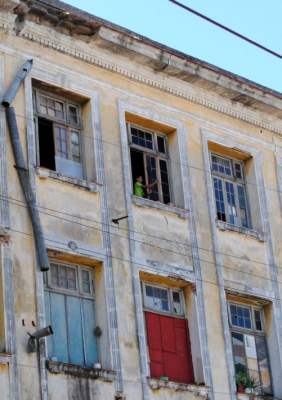 “This was a large school. It had a theater, a cafeteria, storage rooms, a physical education area and workout rooms. In all, we had 1,400 students here. I taught here…from first grade to the fourth – and in all subjects… But now, look at the condition the school’s in… such an old school, look at the quality of construction it once possessed. If it had been kept up like it should have, it wouldn’t be in this pitiful shape…”
“This was a large school. It had a theater, a cafeteria, storage rooms, a physical education area and workout rooms. In all, we had 1,400 students here. I taught here…from first grade to the fourth – and in all subjects… But now, look at the condition the school’s in… such an old school, look at the quality of construction it once possessed. If it had been kept up like it should have, it wouldn’t be in this pitiful shape…”
But how did these people come to live in this place, which was never intended for residential use and is practically devastated?
Estrella (who has lived in the building for fifteen years): “I married a teacher who worked at this school. He taught here for 19 years. The apartment was part of the pay package they gave him when he was working here.”
Gladys: “Actually, I began living here before I started working at this school. I worked in another school and they gave me a place here as part of my compensation. Then they transferred me here to strengthen the school’s Communist Party chapter.”
Yoel (who has lived in the building nine years): “I came here to work for the Military Committee. Previously, where I stay now was a storage room for gas masks of that Committee, and I was a cook here. I didn’t have a place to live because I separated from my wife after more than twenty years of marriage. I was left without a home.”
Sonia (a Public Health worker with more than forty years in the building,): “My mother came here as the director in 1962. It was a boy’s boarding school, for poor children. Before the Revolution there were also poor children here, but the priests worked with them. It was an ecclesiastical school.
“Here there were, for example, boys with behavioral problems… That was before this became the Center for Female Continuing Education. I wound up living here since my mother was the director. Later she transferred to work in another school, but I continued living here. Ever since then we’ve struggled to maintain it… they’ve told us they’re going legalize it to us…
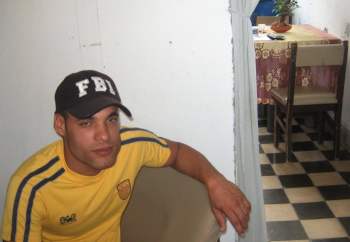
“In reality, this is part of my pay. First with the Ministry of Education and now I think with Popular Power (City Council). Where I live was a housing unit for a priest, so has its own bathroom and kitchen, but it’s falling apart, like the architects have explained to me. The foundations have given way.
Amilkar, (president of the Committee for the Defense of the Revolution, the son of Estrella’s husband, sixteen years living in the building): “In 1992 this building was vacated as a school. At that time my father was married and lived out in the Parraga community; so when this place was emptied they came here to live. She’s the daughter of Gladys, who was a teacher at this school and who still lives here.
“In 1994 my mother died, when I was living in the city of Bayamo. A year later I came here to live with my dad. He got leptospirosis in ‘94, and when he checked out of the hospital, he went to the Municipal Office of Education to speak with the personnel person who was assisting him since he had separated from his wife. They told him that he could stay here, but he didn’t get any documentation confirming this, which was a big mistake.
“That’s why people say we’re here legally and illegally: We’re legal by word but illegal in terms of documents. Here no one has ownership rights, not even those people who have been here more than forty years. They have authorization to be here; for example, like Sonia, who got it from the National Assembly or from the Ministry of Education. A man who now lives in Spain got authorization from the Municipal Office of Education.
“All of them were teachers; the youngest of us who came here to live were from the families of teachers. In ‘95 I came to live with my dad, and in 2000 I decided to live alone. This room was empty so I moved in here. My file within the Housing Authority is separate from my father’s. When they put piped in gas to the city they came here and all the apartments in the building were connected.”
And the ration book?
Amilkar: “Only those people who have lived here more than forty years have one for this address. Mine lists my aunt’s house as my address, which is also the address on my ID card. All of that is in my Housing Authority file and has been signed off on by all the appropriate government authorities of the municipality (the secretary of the Party, the coordinator of the Committees for the Defense of the Revolution, etc.). So, I go to my aunt’s neighborhood every month to get my rationed staples.”
If the building was determined to have been dangerous for the students, how could they let families live here who had rooms as part of their pay; and how is it that other people came here?
Estrella: “Like with everything – out of necessity. The housing shortage we have here makes people give birth to macho kids.”
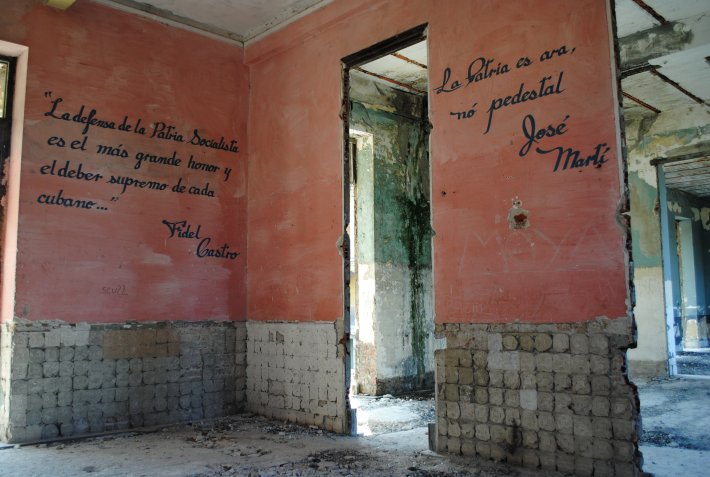
What happened with the students and teachers when the school closed?
Gladys: “We scattered out all over the Tenth of October municipality. Currently the Pedro Maria Rodriguez Elementary School is functioning at another site. There were different houses made into schools and I was directed to work in one near Juan Delgado Park. I retired there.”
What happens during hurricanes?
Gladys: “Well, I go to my sister’s house. Other families pick up the rest of the people, or if not, the government does… the shelter brigade people come. No one stays here. And if they do, it’s on them…it’s their own responsibility.”
Amilkar: “During hurricanes no one comes here to find out about us.”
But yesterday, one neighbor told me that members of Civil Defense come here but no one wants to leave…
Amilkar: “Civil Defense comes when they want to… “
Estrella: “In the last one, which caught us by surprise, pieces of the roof fell off and children began to scream. One resident had a telephone, so I was the one who called the command post for them to send transportation over here. I told them that there were children here screaming, but no one showed up… When there’s a hurricane, it’s not that no one wants to leave – we can’t leave! The women and children go, but the men have to stay because it’s during hurricanes that people break in and steal things.”
But isn’t it especially during hurricanes when the building’s residents help each other out?
Amilkar: “If you have to nail up a window, the people here will help you; that’s no problem at all… Here, in the end, no one has any more problems than the other person. We’re all in the same boat, until we see what happens.”
Do the authorities know about this situation? Have any of you written to them about these problems?
Gladys: “We’ve complained to everybody; we’ve written to everybody. Not only for those of us who live here, but so they’ll save our school.”
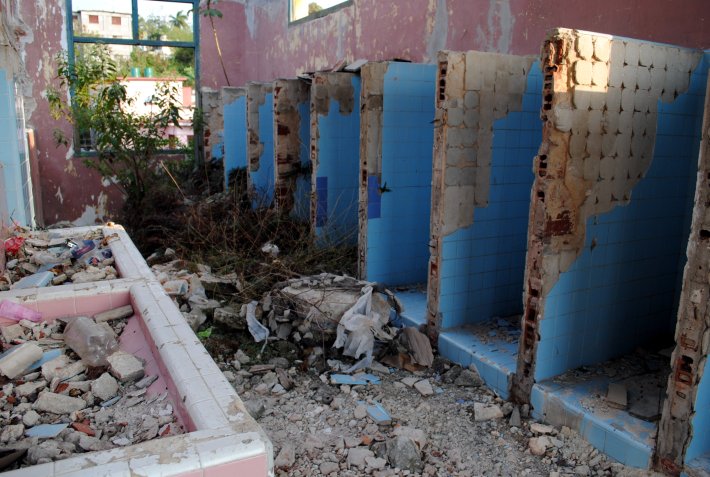
In 2008, Amilkar wrote a letter to the President of the Republic of Cuba, Army General Raul Castro Ruz; and to Pedro Saez Montejo, the First Secretary of the Communist Party of Cuba in the City of Havana:
“In it I told them about the history of the building, and there are some of the photos I sent… I talked about how people come here to smoke marijuana in the yard, and about one police officer who came here and started shooting…”
Estrella: “We’ve already written everywhere, we’ve taken photos, we wrote to the Central Committee, everything… Do you see what’s back there? That was the bathroom for all the families when we lived upstairs. We don’t have bathrooms inside the rooms. We do our business in buckets…in plastic bags from the store.
“The bathrooms were shared. When they said they were going to build 64 apartments, they demolished parts of the building and left us without a bathroom. Before, we didn’t have toilets inside the units; now we don’t have them inside or out.”
Gladys: “I have a grandson who’s studying engineering at ITM. He has also complained at all the same places as Amilkar. He’s written to everybody, he’s seen everybody and he’s explained my problems in a newspaper column, talking about the conditions I live under. At night, if you have a stomachache you have to walk a block to go to the bathroom. I’m using one that belongs to a resident who lived in a very bad part of the building and couldn’t stay here with her daughter and a little boy. Now she’s living in her ex-husband’s house, so she lent their bathroom to me and my daughter. The other residents are using one that belonged to a family that left for Spain.”
What responses have you received?
Amilkar: “I didn’t receive any answer to the letter I wrote to Raul. As for the one I sent to Saez, I was only informed that it was sent to Popular Power.”
Gladys: “The government of the municipality told my grandson that they were going to install a bathroom for me inside my unit.”
 Amilkar had told me that previously there had been an inspection by the Military Committee because the gas masks (which were being stored in the school’s old theater) were being stolen: “The kids were taking them to make slingshots… They were also in pretty bad condition, because the place where they were stored leaked. Everything was wet. It got to the point that I quit even doing maintenance to preserve the equipment.”
Amilkar had told me that previously there had been an inspection by the Military Committee because the gas masks (which were being stored in the school’s old theater) were being stolen: “The kids were taking them to make slingshots… They were also in pretty bad condition, because the place where they were stored leaked. Everything was wet. It got to the point that I quit even doing maintenance to preserve the equipment.”
“As a result of that inspection, a meeting was held with the comrades of the building and four of them were given a deadline of 72 hours to leave, because they had lived here for only a short time. The rest were promised a housing unit. I have all of this stated in a letter.
“Of those people who were supposed to leave, one of them stayed: Yoel. They even fined him, but he hasn’t left. The other person was Leonor. She had been here for only a few months so she left, I don’t know where. Miriam also stayed for a while, but she left later on. The other was Julian, but he died.
“In that meeting they asked us about our willingness to work on a brigade building our own homes and they promised us the land to build on. That was the first and only meeting in which that issue was talked about.
“After a while the repairs started, but no one informed us about anything; nor were we told what they were going to do with us. People from the SECOM Company came, but they weren’t responsible for the building and didn’t kick any of us out.
“They wasted a lot of materials. They built a wall around the building, brought in a cement container and on the corner delivered rebar, framing lumber, those beams you see in the corridor, and they set up a dining room and a sentry post – a little bit of everything.
“Supposedly there would be 64 apartments constructed, but we only got word through rumors. Downstairs there was a meeting with the municipal director of Housing. Though we weren’t invited, we went in. This was how we found out that we were included in the apartments that they were going to build. In that meeting they also talked about the leaves of absence people who were going to get to participate in the construction.
“But for this, the Ministry of Labor and Social Security demanded to know the exact start and finish dates for the housing. The municipal director of Housing said start-up was imminent, though he never said the exact starting and completion dates. I went to see the deputy director of Building for the municipal government, Rafael Duarte Martinez, to ask him about the renovation work and to find out where we would be housed in the meantime.
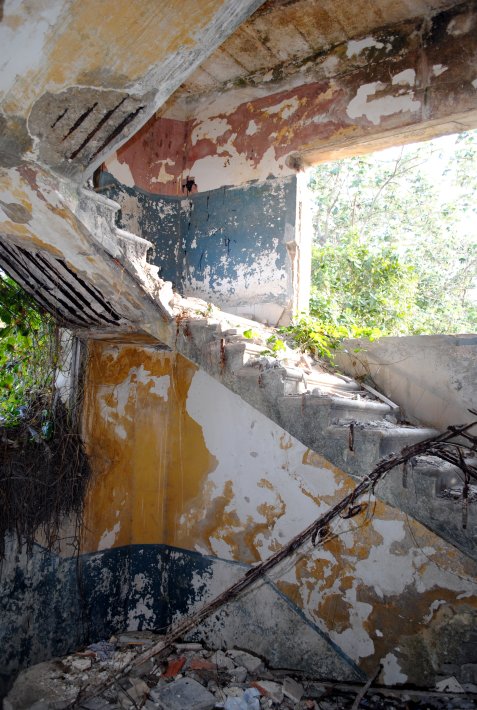 “He told me that they were going to do the repairs in phases, and when the first one was ready they would move the residents into it and then finish the rest. I asked for him to meet with all the residents so that everyone received the information but he told me that he didn’t have to meet with anybody. When I told him that he owed that to the residents, he acquiesced and agreed to come and explain the plan.
“He told me that they were going to do the repairs in phases, and when the first one was ready they would move the residents into it and then finish the rest. I asked for him to meet with all the residents so that everyone received the information but he told me that he didn’t have to meet with anybody. When I told him that he owed that to the residents, he acquiesced and agreed to come and explain the plan.
“The residents agreed and it was explained that the Salvador Allende Contingent would come. I began writing my request for a leave of absence letter, but they didn’t grant it to me due to the lack of start-up and completion dates. These leaves were in fact granted to three residents (Yoel, Aida and Elvira), but the latter one — when seeing that construction hadn’t begun — returned to her job. The other two continue working with the contingent.”
Today’s Reality
Amilkar: “In the end, nothing was done. They delivered some materials to the contingent, and they stole others. I imagine they must have spent ten million pesos. There were enough materials to construct two buildings.”
Gladys’ sister, who lives near the building, seem a little skeptical of the report in Havana Times, but she also commented: “They began to make the repairs, but as a result of problems with the foundations, which were giving way, they had to stop the repair work.”
Amilkar: “But there already existed a study that said the foundations were not holding up. Why did they say they were going to do the construction? Why did they deliver all those materials, and build up people’s hopes? They’re playing with people’s feelings and with their vital needs. The problem is that this verdict was already in before the SECOM builders showed up. Down below are some huge holes that were dug to do the foundation testing.”
Gladys: “I’ve gone for more than a year hoping they’d come and put in my bathroom.”
Estrella: “They’ve tricked us; they’ve tricked us too much.”
Three residents from the building remain on leaves of absence from their jobs to participate in building their own housing. But since the renovation of their building was canceled, they’ve gone on to participate on other construction jobs. Their workplaces cannot reinstate them if they haven’t resolved their housing situation.
Amilkar: “The only thing lacking is to collect all the construction belts and dump them in some government office. There are those who say that this would be creating a political problem, but the political problem is already here… Right now I can’t call CDR members to an assembly to discuss crime. What assembly against crime am I going to convene if criminal acts are being committed here and there doesn’t exist a way to ultimately resolve them? I had to negotiate on my own with that policeman who was firing shots out in our yard. The only thing that happened was that the Popular Council transferred him.
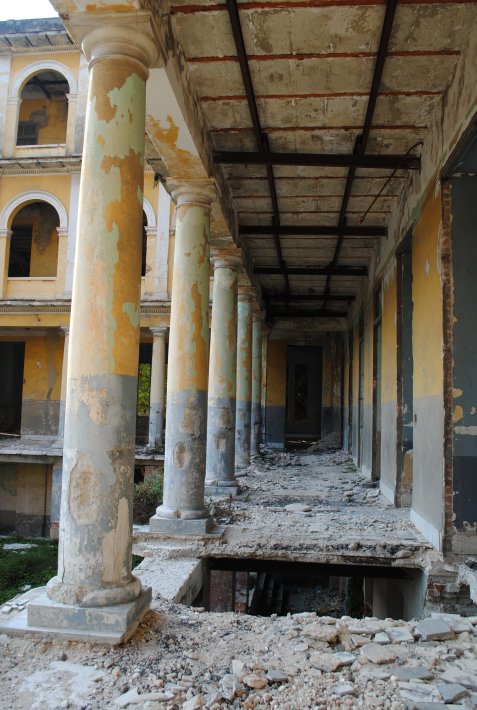 “If we don’t handle things ourselves nothing happens. And like I said, a policeman like that is a danger to society, because he’ll empty his gun on anyone. He was the head of part of district 95… To top the whole thing off, the previous local delegate Report-back Assembly was canceled because I refused to convoke the CDR members; I wanted an answer first about what happened with all the building materials that had been delivered and what happened after they met with all the residents to say they would assemble the 64 apartments…
“If we don’t handle things ourselves nothing happens. And like I said, a policeman like that is a danger to society, because he’ll empty his gun on anyone. He was the head of part of district 95… To top the whole thing off, the previous local delegate Report-back Assembly was canceled because I refused to convoke the CDR members; I wanted an answer first about what happened with all the building materials that had been delivered and what happened after they met with all the residents to say they would assemble the 64 apartments…
“Well, the assembly was postponed and postponed. The Municipal Assembly of Popular Power was constituted but a Report-back Assembly was never held in this district. Our disappointment isn’t only because they can’t address the problem; we understand the situation the country is going through, but the lack of respect is too much.”
What perspectives do you have of being able to solve your problem?
Yoel: “They explained that we would have an assigned housing unit here, but they don’t know if these will be covered in the budget for this year or next. They tell us that we can do the remodeling work, but almost all the people here are elderly. I was released from my regular job three years ago to work on a construction contingent. I worked as a cook under the Ministry of Education. I have spent one year and two months in the micro-brigade here, in the Tenth of October municipality, so now I’ve been working for two years in the Salvador Allende Contingent, which was the one that was going to repair our building. Notwithstanding, I’m not entitled to housing though the contingent, it’s here on behalf of the government… Now we have to wait for the materials and the budget.”
Gladys’ sister: “Now they’re waiting to move to another place when they finish building.”
Gladys also shows herself to be optimistic: “Everything is now approved and the planning is completed. They’re going to develop a building with 12 apartments for us and we’re waiting for that to get out of here. We don’t know what they’ll do with this building.”
Has the construction already begun?
Gladys: “Not yet. They’re working on that… The land is there, and so is the planning… So within a few months, or one year, or two, we’ll be living in another place.”
Her sister thinks this will happen at the end of this year, and she then asked me what else I wanted to know.
 Amilcar: “As for the prospects up to now, there aren’t any. They’ve made promises and more promises. It was said that there were some warehouses on Capricho Street, in the Luyano neighborhood, that these were going to be repaired. But in the end…nothing. We found out about these housing units through the answer that was given to a letter written by Alejandro, one of the building’s residents. But according to that letter, there were only ten families here, and I wasn’t included.
Amilcar: “As for the prospects up to now, there aren’t any. They’ve made promises and more promises. It was said that there were some warehouses on Capricho Street, in the Luyano neighborhood, that these were going to be repaired. But in the end…nothing. We found out about these housing units through the answer that was given to a letter written by Alejandro, one of the building’s residents. But according to that letter, there were only ten families here, and I wasn’t included.
“No one came personally to see how many families were really living here. I’m telling you all this because nothing that happens here is secret to anybody… A housing inspection took place here because there had been a plastics factory downstairs. It was seemingly legal, but later it was discovered that it wasn’t.
“In the inspection, people came everywhere from the community architect’s office to the housing investment group. The objective was never the residents who live in the building. Then they began asking to see everyone’s ID card, and those who didn’t have the address of this place were fined.
“With this I’m telling you that the executive staff of the Housing Authority has come here to do everything from carry out a census to hand out fines, yet there’s not even an estimate as to when or how the problem of us residents who live here in this building will be resolved. We still don’t know if the solution to this problem is included in the municipal government budget for this year. Yoel went to the government office and they told him they didn’t know; he went to the Municipal Investment Unit for Housing and they told him they’d have to check to see if it was included. I suspect it’s not, but no one has come to inform us.”
Despite the vicissitudes, the unfulfilled promises and the disappointments, the residents have not lost their capacity for solidarity. Music videos and scenes from movies have been filmed in the building; one of those is “Madrigal,” by renowned director Fernando Perez. The residents cooperated by offering the actresses and actors cold water and rooms for them to put on their makeup or change their outfits. Meanwhile, the residents continue to wait for a solution…some with optimism; others skeptically.
In the recent meeting to discuss the Communist Party’s “Guidelines” [on Cuba’s planned reforms], Amilkar again outlined the problem of the building and the investment of resources that had been made but was lost in the end: “It’s like what happens in thousands of cases in this country; they provide the resources and in the end someone else steals them, and the project ends there…”
The response he received was that this was not a Report-back Assembly and that they should wait for what was approved in the upcoming party congress. “They told me that this document was the ‘what’ and that the ‘how’ would come later; so we’re stuck in the same sad situation: waiting for the how, the how, the how… and in the end we don’t find it.”
Click on the tumbnails below to view all the photos in this gallery
























Hello Folks,
I hope you mean it when you state:
“Open-minded writing from Cuba”
I escaped from The Cuban Communist Paradise in the 70s.
I have traveled all over the world.
I understand the polarizations in opinion.
Here are my 2 cents, as they say in the English-Speaking World.
There is truth lies on both sides of the fence.
Just a reminder to the reader so that my comments can be put into context…
Today is September 11th, 2011.
If you search for “The Truth” about this date
(excluding the Pinochet Coup of Allende: 9-11-1973),
you will be surprised.
Those who know The Beast would say:
“I told you so.”
Those who don’t would say:
“Wow, I did not know that.”
In English we have:
“Power Corrupts and Power Corrupts Absolutely.”
Thus, a totalitarian regime like Castro’s Stalinist-Style Dictatorship did not have much future.
But wait…
In the 10th Anniversary of US 911, let us not forget all the crimes perpetrated against humanity by the good old USA.
Let us not talk about Cuba because the anti-Castro extremists would eat me alive.
I am talking about the Arab countries.
Let us take only the case of Iraq (invaded illegally and unjustifiably in 2003).
If you are curious, input in your Browser the key phrase:
“Depleted Uranium”
This material is also known as DU.
After taking time to learn about DU, add Iraq:
“Depleted Uranium”+Iraq
Spend time learning about what is going on.
For those who really know about Cuba, the situation will remind Jose Marti’s words:
“Vivi en el Monstruo y le conozco las entranas.”
Translation: “I lived within the Monster and I know its guts.”
I am not apologetic of Castro’s crimes.
I am just saying that one needs to do serious introspective analysis.
When I travel Latin-America and see children digging in the dumps I say to myself:
“Yep, we need Castro around here.”
Then I add:
“Yep, but just for a couple of months.”
So, it is world-wide perspective what we need.
Do not ever forget the Open and Secret Policies of the US against Cuba.
Compare then with those of the US with Mighty China.
Ask yourself: Why would the Good Old USA help Communist China and not Communist Cuba?
The US Government(s) has constantly answer: “US Interests”
Do not let the Propaganda Machine (on either side) blind your thinking.
Look for The Light of Truth and You Shall Find It!
God Bless!
V
These ruins remind me of what it must have looked like in Rome during the first centuries after the collapse of the empire, say from the late 400’s ’til 600 or 700 A.D. So sad. So much of Cuba’s architectural patrimony has been, and is daily being, lost. There is something haunting about the passage of time. Ghosts haunt these buildings. It reminds me of the ruins of the grand hotel and baths at San Miguel de los Banos, in Matanzas. As grok sez, “What does this tale, multiplied thousands-fold across Cuba, tell us about the present centralized, top-down structure of this ‘de facto’ Stalinist version of socialism?” This loss, however, is not particular to Cuba. Some months back the GUARDIAN (U.K.) had a photo essay on the ruined architectural jewels of Detroit, Michigan, which was equally as haunting. In the ruins photographed by Irina are the architectural orders and elements used since classical times. Individual examples fall to ruins, or even dust, as they have always have, yet the pure forms will persist in the mind’s eye ’til the end of time–or at least ’til the end of our comical and absurd species!
The absurdity of this wasted building is emblematic of Marxian, state-ist socialism. Thanks, Yusimi and Irina, for a sad but interesting slice of life.
Why is it that some people can see that a “centralized, top-down” form of socialism doesn’t work, yet cannot see or admit that it was Marx and Engels, not Stalin, who formulated this “state-owns-everything” formula.
What is happening is that Trotskyists are trying to pretend that Marx and Engels didn’t dish up the state-ist redefinition of socialism. This deliberate blindness is apparently members of a quasi-religious cult of personality trying to save their discredited secular religion.
One tale told of a society in near-permanent disarray… But some of the government’s defenders obviously read the commentary here on Havana Times and can only see the criticism — and interpret it as unjustified, in their typical knee-jerk way.
So tell me, ‘defenders of the Revolution’: what does this tale, multiplied thousands-fold across Cuba, tell us about the present centralized, top-down structure of this ‘de facto’ stalinist version of “socialism”..?